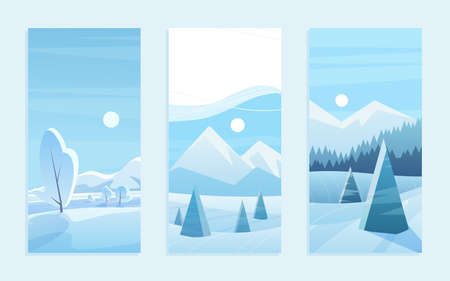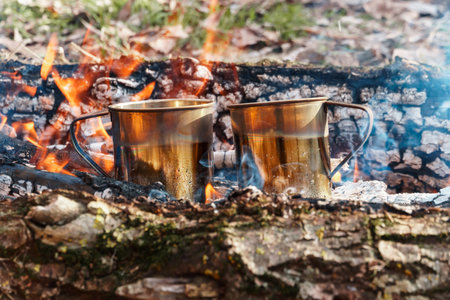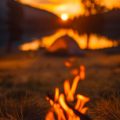1. Layer Up the Right Way
Staying warm during winter camping starts with how you dress—and that means using a smart layering system. Dressing in layers helps trap body heat while allowing you to manage moisture and regulate your temperature throughout the day. The key is to build your outfit using three main layers: base, mid, and outer.
Understanding the Three-Layer System
Each layer has its own job to keep you dry, insulated, and protected from the elements. Heres a simple breakdown:
| Layer | Purpose | Recommended Materials |
|---|---|---|
| Base Layer | Wicks sweat away from your skin to keep you dry | Synthetic fabrics (like polyester), merino wool |
| Mid Layer | Traps body heat to provide insulation | Fleece, down, synthetic insulations like PrimaLoft |
| Outer Layer | Shields against wind, snow, and rain | Waterproof/breathable shells like Gore-Tex or similar materials |
Tips for Choosing the Right Layers
- Avoid Cotton: Cotton absorbs moisture and dries slowly, which can lead to getting cold fast. Always go for moisture-wicking materials.
- Add or Remove Layers: As your activity level changes—like hiking vs. sitting around camp—adjust your layers to avoid sweating or getting chilled.
- Fit Matters: Your base layer should be snug but not tight, mid layer should fit comfortably over it, and outer layer should allow room for both without being too loose.
Pro Tip:
If youre feeling cold at night, try wearing a fresh base layer to bed. Dry clothes help retain warmth better than damp ones youve worn all day.
The Bottom Line on Layering
Dressing in layers isn’t just about piling on clothes—it’s about choosing the right combination of materials that work together to keep you warm and dry. Once you master this system, youll be way more comfortable no matter how low the temps drop on your next winter camping trip.
2. Master the Art of Sleeping Warm
Staying warm overnight is one of the biggest challenges when winter camping. The temperature can drop fast after sunset, and if youre not properly prepared, it can make for a long, uncomfortable night. Heres how to master your cold-weather sleep setup to keep cozy until morning.
Choose the Right Cold-Rated Sleeping Bag
Not all sleeping bags are created equal—especially in winter. Look for a bag thats rated at least 10°F lower than the expected nighttime temperature. For example, if its going to be 20°F outside, choose a bag rated for 10°F or even 0°F just to be safe. Mummy-style sleeping bags with hoods help trap heat more efficiently than rectangular ones.
| Temperature Range (°F) | Recommended Bag Rating | Bag Type |
|---|---|---|
| 30-40°F | 20-30°F | 3-season mummy bag |
| 15-30°F | 0-15°F | Cold weather mummy bag with hood |
| Below 15°F | -10°F or lower | Expedition-grade down bag |
Layer Up Your Sleep System
Your sleeping bag is just one part of your sleep system. To stay truly warm, you need to insulate yourself from both above and below. Use an insulated sleeping pad rated for winter use to prevent heat loss to the ground. For extra warmth, double up with a closed-cell foam pad underneath.
Pro Tip:
A reflective emergency blanket placed under your sleeping pad can help bounce body heat back toward you.
Wear the Right Sleepwear
Avoid wearing damp clothes to bed. Instead, change into dry base layers made of wool or synthetic fabric before crawling into your sleeping bag. Avoid cotton—it holds moisture and can make you colder.
Best Sleepwear Materials:
- Merino wool base layers
- Synthetic thermal tops and bottoms (like polyester blends)
- A fleece beanie and dry socks for added warmth
Additional Heat Hacks for Cold Nights
- Nalgene Bottle Trick: Fill a leak-proof bottle with hot water and tuck it into your sleeping bag (near your core or feet).
- Stuff Your Bag: Fill empty space in your sleeping bag with clothes to reduce cold air pockets.
- Breathe Outside the Bag: Keep your face outside the sleeping bag to avoid moisture buildup inside from your breath.
- Sock Swap: Change into a clean pair of dry socks right before bed—your feet will thank you.
A well-planned sleep setup is key to enjoying winter camping without shivering through the night. With the right gear and a few smart techniques, you’ll wake up rested and ready for whatever adventure lies ahead.

3. Choose the Right Campsite
Picking the right spot to set up camp is one of the most important decisions youll make when winter camping. A smart campsite choice can mean the difference between a cozy night and a freezing one. Heres how to choose wisely:
Avoid Wind Tunnels
Strong winds can quickly suck the warmth out of your tent and body. Stay away from open ridges, valleys, or spots between two slopes where wind tends to funnel through. Instead, look for natural features like trees, rocks, or hills that can block the wind.
Watch Out for Low Spots
Cold air sinks, so avoid camping in low-lying areas such as valleys, dry creek beds, or dips in the ground. These spots tend to collect cold air overnight and can be several degrees colder than higher ground nearby.
Use Natural Windbreaks
Trees, boulders, or even snowbanks can work as effective windbreaks. Position your tent behind these barriers so they shield you from prevailing winds. This helps trap warmer air around your tent and reduce heat loss.
Best Campsite Features for Staying Warm
| Feature | Why It Helps |
|---|---|
| Tall Trees or Forest Edge | Blocks wind and traps warmer air |
| South-Facing Slope | Catches more sunlight during the day for natural heating |
| Behind a Rock or Snowbank | Acts as a wind barrier without blocking sunlight |
| Flat Ground (not in dips) | Keeps you above cold-air pockets that settle in low areas |
Quick Tip:
If youre unsure about a spot, take a moment to observe wind direction by tossing some grass or snow into the air. Also, notice where snow has drifted—that’s often a sign of strong wind patterns you’ll want to avoid.
Choosing the right campsite doesnt just improve comfort—it boosts safety too. Make this step a priority every time you set up for a winter adventure.
4. Food and Hydration Hacks for Warmth
When youre camping in freezing temperatures, your body needs extra fuel to stay warm. Think of food as your internal heat source — the right meals and drinks can help you maintain energy, regulate body temperature, and keep those shivers at bay.
High-Calorie Meals: Fuel Your Internal Furnace
Cold weather burns more calories, even when youre resting. To keep your internal furnace running strong, focus on high-calorie meals packed with healthy fats, proteins, and complex carbs. Heres a quick guide to winter-friendly camping foods:
| Food Type | Examples | Why It Helps |
|---|---|---|
| Healthy Fats | Nut butters, cheese, trail mix with nuts and seeds | Slow-burning energy that keeps you full and warm longer |
| Proteins | Jerky, hard-boiled eggs, canned tuna or chicken | Aids muscle recovery and sustains energy levels |
| Complex Carbs | Oatmeal, whole grain wraps, pasta | Provides steady fuel for long-lasting warmth |
Stay Hydrated — Yes, Even in the Cold!
Dehydration sneaks up faster in cold weather because you may not feel as thirsty. But staying hydrated is crucial — water helps regulate body temperature and keeps your metabolism working efficiently. Aim to drink small amounts regularly throughout the day.
Tips to Stay Hydrated in Winter:
- Keep your water bottle inside your sleeping bag overnight to prevent freezing.
- Add a pinch of electrolyte powder to help retain fluids.
- Avoid drinking too much caffeine or alcohol — they can dehydrate you.
Warm Drink Ideas to Beat the Chill
Sipping something hot is one of the fastest ways to warm up from the inside out. Try these cozy drink options around the campfire or before bed:
- Hot Chocolate with Peanut Butter: Add a spoonful of peanut butter for extra calories and flavor.
- Spiced Apple Cider: Heat up apple juice with cinnamon sticks and cloves.
- Bouillon or Broth: A salty soup base helps replenish electrolytes and warms you quickly.
- Golden Milk: Mix warm milk (or non-dairy alternative) with turmeric and honey for anti-inflammatory benefits.
The key to winter camping comfort is keeping your body fueled and hydrated. With smart food choices and warming beverages, youll be better equipped to brave the cold and enjoy every frosty adventure.
5. Campfire and Heat-Boosting Gear Essentials
When youre winter camping, staying warm isnt just about layering up—its also about having the right heat sources and knowing how to use them safely. From building a solid campfire to using portable heaters and hot water bottles, here’s what you need to know to stay cozy without putting yourself at risk.
Build a Safe and Efficient Campfire
A good campfire is more than just ambiance—it’s your main source of warmth. Choose a fire ring or designated fire pit whenever possible, and always clear away snow or debris before starting your fire. Use the “log cabin” method for better airflow: stack two logs parallel on the bottom, then lay two more on top at a 90-degree angle. Add kindling in the center and light it up.
Fire-Building Quick Tips:
- Use dry wood: Wet or green wood won’t burn efficiently and creates smoke.
- Carry fire starters: Waterproof matches, lighters, or commercial fire starters make ignition easier in cold conditions.
- Keep extra wood covered: Snow-dampened logs won’t help much when the temperature drops.
Portable Heaters: Use with Caution
Portable propane heaters, like the popular Mr. Heater Buddy series, are a favorite among experienced winter campers. However, they should only be used in well-ventilated areas to avoid carbon monoxide buildup. Never sleep with a heater running inside your tent unless its rated for indoor use and has safety features like automatic shutoff.
Popular Portable Heaters Comparison
| Heater Model | Indoor Safe | Auto Shutoff | Power Source |
|---|---|---|---|
| Mr. Heater Little Buddy | Yes | Yes | Propane (1 lb) |
| Coleman BlackCat Catalytic Heater | No (Ventilation Required) | No | Propane (16 oz) |
| Zodi Hot Vent Tent Heater | Yes (Indirect Heating) | N/A (External Unit) | Propane & Battery Fan |
The Power of Hot Water Bottles
This old-school trick still works wonders: fill a durable Nalgene bottle with hot water from your camp stove, seal it tightly, and toss it into your sleeping bag before bedtime. It will radiate heat for hours. Just make sure the bottle is leak-proof and rated for high temperatures.
Pro Tip:
You can place one bottle by your feet and another near your core for maximum warmth throughout the night.
Other Heat-Boosting Gear You Should Pack
- Insulated ground pads: Prevent heat loss through conduction from the cold ground.
- Tent-safe electric blankets: Powered by portable battery stations for safe overnight use.
- Chemical hand warmers: Great for pockets, gloves, or even inside socks before bed.
Remember:
Your goal is to layer your heat sources safely—combine passive insulation (like sleeping pads) with active heat (like hot water bottles or a controlled campfire) to create a warm environment without putting yourself at risk.


